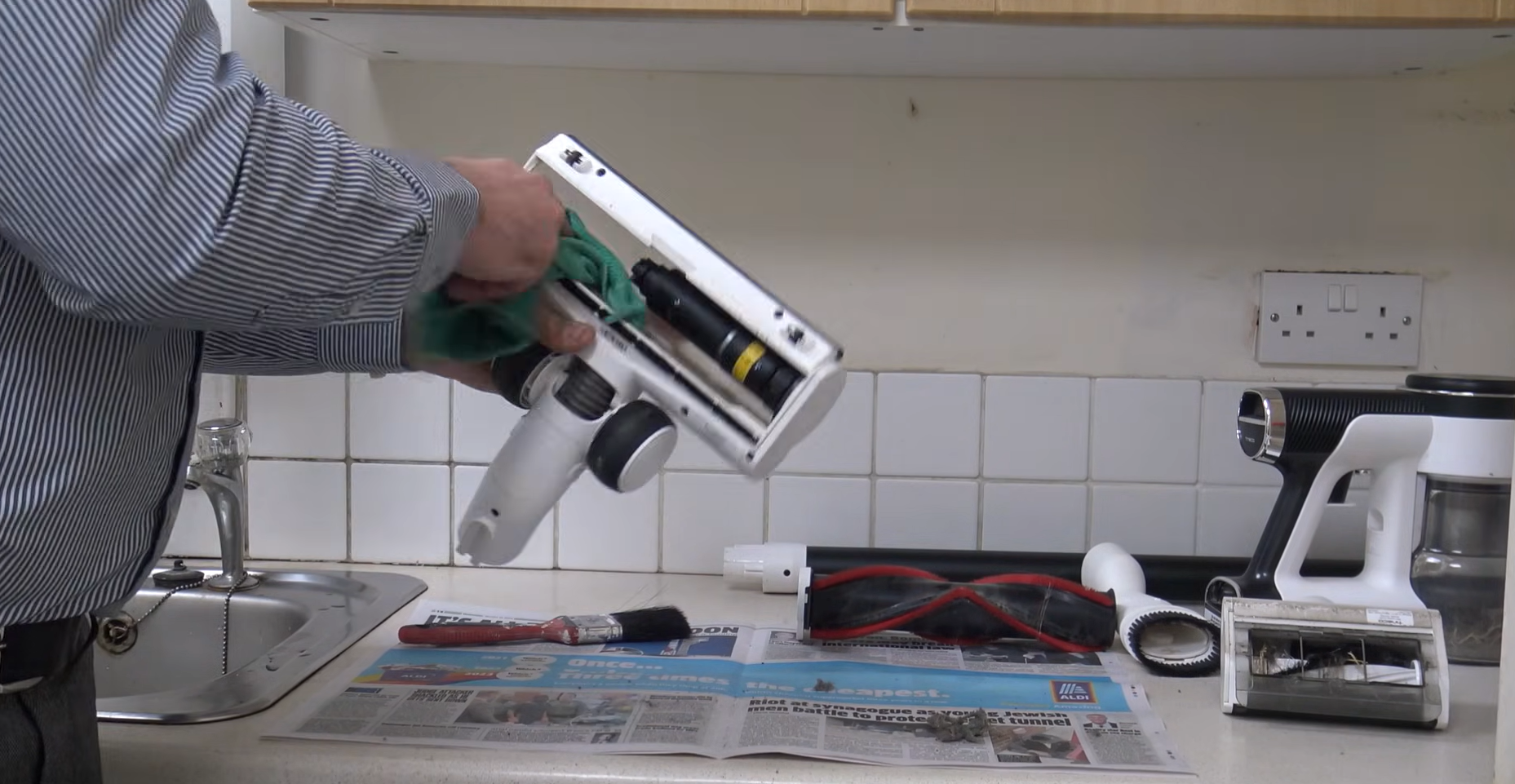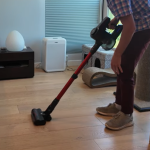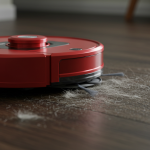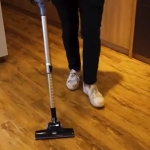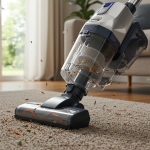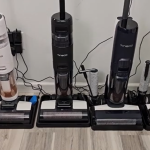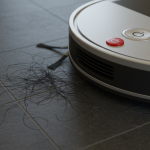Ever notice your cordless vacuum struggling to pick up dirt, making strange noises, or leaving dust behind? These are clear signs that your vacuum needs some attention. Learning how to clean and maintain a cordless vacuum cleaner properly isn’t just about keeping your floors spotless, it’s about protecting your investment and making sure your vacuum lasts for years.
From simple daily habits like emptying the dust bin to deeper monthly cleaning of filters, brush rollers, and attachments, a little care goes a long way. This guide will walk you step by step through spotting warning signs, cleaning routines, maintenance tips, and storage advice, helping your vacuum perform at its best every time.
Whether you’re a first-time cordless vacuum owner or a seasoned cleaning pro, these easy-to-follow tips will keep your vacuum running efficiently, extend its lifespan, and even help prevent odors or clogs from slowing it down.
Signs Your Cordless Vacuum Needs Cleaning
Even the best cordless vacuum cleaners need regular care to perform well. If you’re still deciding which model is right for your home, you can explore our guide on the best cordless vacuum cleaner to compare top options and choose one that fits your cleaning needs.
If you notice any of the following signs, it’s time to give your vacuum a proper cleaning to keep it working efficiently:
- Loss of suction: If your vacuum isn’t picking up dirt as it used to, debris might be clogging the filter, dustbin, or brush roller. This is one of the most common signs that your vacuum needs attention.
- Strange or burning smell: A burning smell while using the vacuum usually means dust or hair is stuck in the motor or brush roller. Ignoring it can damage your vacuum over time.
- Overheating: If the vacuum feels unusually hot, it could be struggling due to blockages or a dirty filter. Turn it off immediately and check for obstructions.
- Short battery life: A cordless vacuum losing battery power faster than normal may indicate that it’s working harder than it should because of dirt buildup or a clogged filter.
- Brush roller stops spinning: Tangled hair, threads, or debris can prevent the brush roller from turning. This reduces cleaning efficiency and can damage the motor if left unattended.
- Dust escaping from the vacuum: If you see dust escaping from the dustbin or nozzle, it’s a clear sign that your filter is dirty or not seated properly.
- Unusual loud noise: Grinding, rattling, or other odd sounds are usually caused by blockages in the hose, brush roller, or attachments. Cleaning these parts often solves the problem.
To better understand why dust escapes or why blockages form inside your vacuum, it helps to know how indoor dust is created. The EPA explains the major sources of indoor particulate matter, including dust, fibers, and allergens that your vacuum picks up daily.
What You Need Before You Start
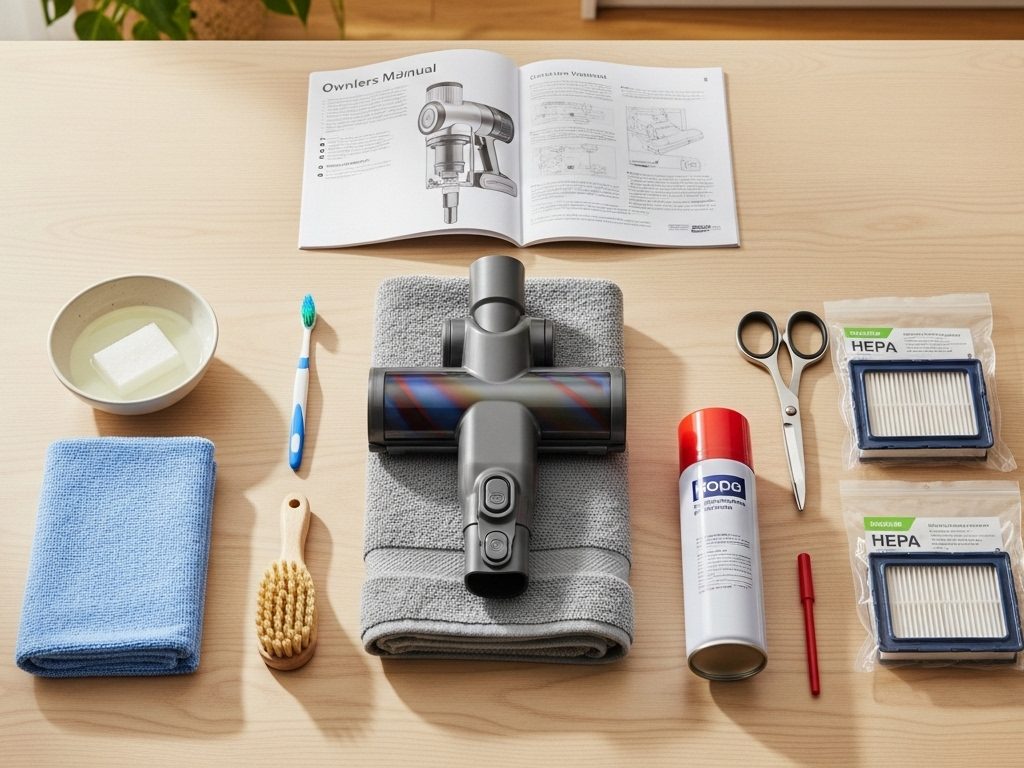
Before you dive into cleaning your cordless vacuum cleaner, it’s a good idea to gather a few essential tools and supplies. Having everything on hand will make the process smoother, faster, and less frustrating. Here’s what I recommend keeping nearby:
- Soft cloth: Perfect for wiping down the vacuum’s exterior without scratching it.
- Small brush or old toothbrush: Ideal for getting into tight spaces, corners, and crevices where dust tends to hide.
- Mild soap: Use this with water to gently clean washable parts like dust bins and some attachments.
- Dry towel: To dry off any parts you’ve washed so that nothing gets damaged when reassembling.
- Scissors: Handy for carefully cutting away hair or threads tangled around the brush roller.
- Compressed air (optional): Great for blowing out stubborn dust from hard-to-reach areas, like vents or inside the motor compartment.
- Replacement filters (if needed): It’s always smart to have a spare HEPA or foam filter ready if your current one is worn or damaged.
- Owner’s manual: Every vacuum is a little different, so following the manufacturer’s instructions will help you avoid mistakes and maintain your warranty.
Step-by-Step Guide to Clean a Cordless Vacuum Cleaner
Keeping your cordless vacuum in top shape doesn’t have to be complicated. By following these simple steps, you can ensure your vacuum maintains strong suction, clean filters, and smooth-running brush rollers. Here’s how to do it:
1. Turn Off and Unplug the Vacuum
Before you start, always make sure your vacuum is turned off and unplugged. If your model has a detachable battery, remove it as well. This keeps you safe while cleaning and prevents any accidental starts. Taking a moment to double-check safety now will save headaches later.
2. Empty the Dust Bin / Replace Dust Bag
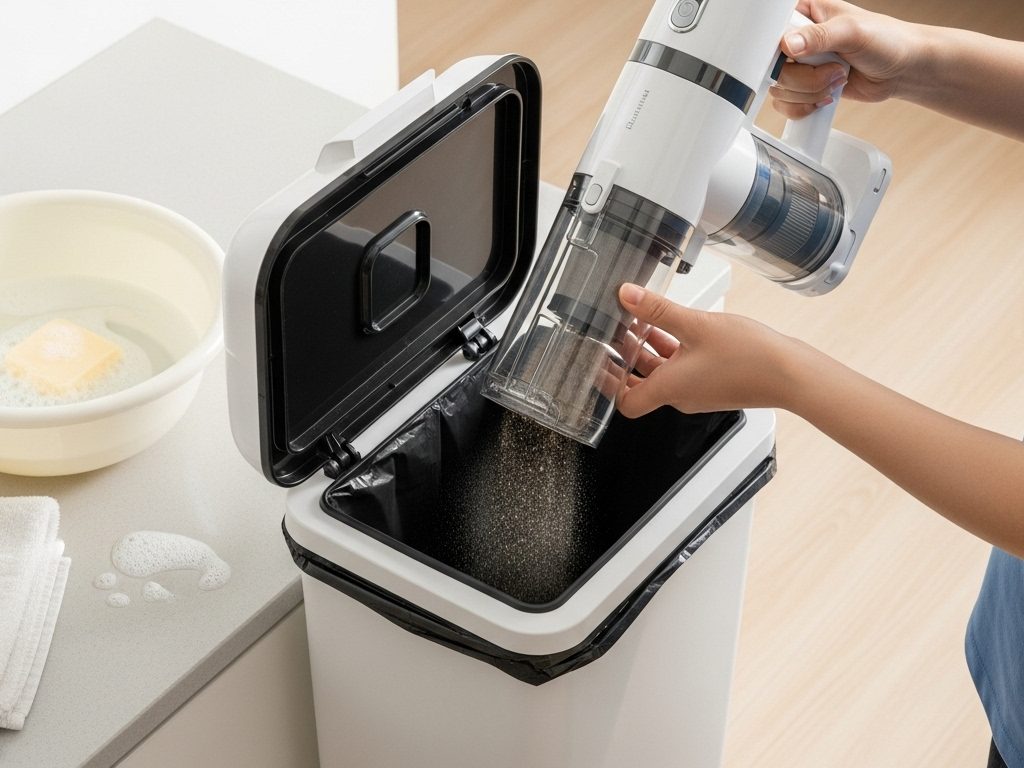
The next step is to empty your dust bin or replace the bag if your vacuum uses one. Always do this after each use to prevent clogs and maintain suction. For bagless models, wash the dust bin with warm, soapy water and make sure it’s completely dry before reattaching it. A clean bin not only keeps your vacuum performing well but also helps reduce odors in your home.
3. Clean the Filter Thoroughly
The filter is the heart of your vacuum’s suction power. Start by removing the HEPA filter and tapping out any dust or debris. If your filter is washable, rinse it under running water and shake off excess moisture. Allow it to dry completely for at least 24 hours before putting it back. Some filters aren’t washable, so make sure you know what type your vacuum uses. Replacing your filter every 3–6 months can make a huge difference in maintaining suction and extending the life of your vacuum.
A properly maintained filter plays a huge role in reducing airborne dust in your home. The EPA’s guide to air cleaners in the home explains how filters capture pollutants and why proper maintenance matters.
4. Clean the Brush Roller
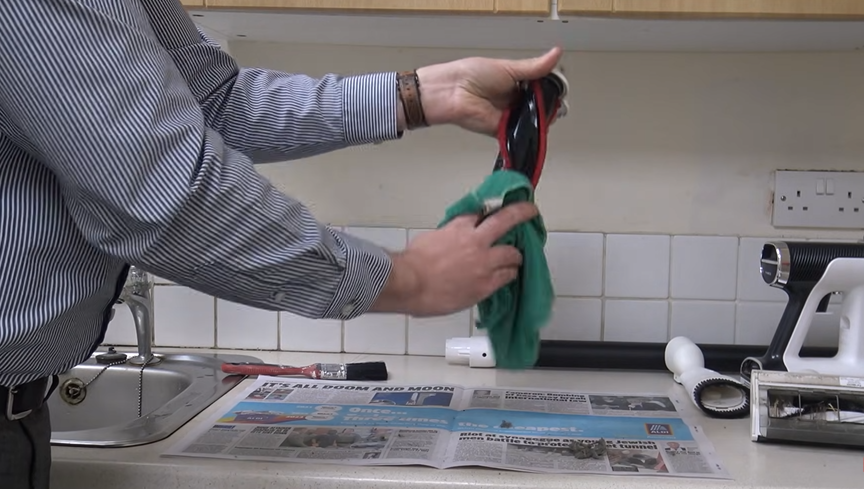
Hair, threads, and other debris often get tangled around the brush roller. Carefully remove these using your hands or scissors. Wipe the roller clean and check that it spins freely. While you’re at it, inspect the nozzle for blockages. A clean brush roller ensures your vacuum picks up dirt efficiently and prevents motor strain.
5. Check for Blockages
Next, take a look at the areas where dirt might get stuck:
- Suction tube
- Air pathways
- Nozzle openings
- Cyclone chamber (if your vacuum has one)
Removing blockages from these areas keeps airflow smooth and prevents overheating.
6. Clean the Exterior
Wipe the vacuum’s body with a damp cloth to remove dust and fingerprints. Don’t forget the LED lights and wheels, which can also collect dirt over time. Make sure all parts are dry before reassembling. A clean exterior not only looks good but also prevents dirt from transferring back into your home.
7. Clean Attachments
Your vacuum’s attachments also need regular attention:
- Crevice tool
- Dusting brush
- Upholstery tool
- Motorized mini-head
Wash washable parts with mild soap and water, and wipe down non-washable ones. Keeping attachments clean ensures they perform well and last longer.
8. Clean and Check the Battery
Finally, take care of the battery. Gently wipe the contacts with a dry cloth and never wash the battery itself. Avoid overheating by keeping it out of direct sunlight or extreme temperatures. Charge your vacuum according to the manufacturer’s instructions to maintain battery health and extend its life.
Deep Cleaning Your Cordless Vacuum (Monthly Routine)
Even if you clean your vacuum regularly after each use, giving it a deep clean once a month can make a huge difference in performance and longevity. Here’s how to do it step by step:
Disassemble Major Parts
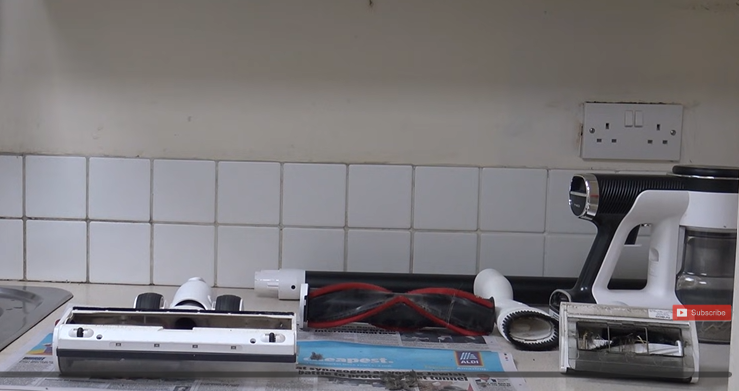
Start by carefully taking apart your vacuum. Remove the dust bin, brush roller, attachments, and any other detachable parts. Having the vacuum broken down makes it easier to clean every nook and cranny, ensuring no hidden dust or debris is left behind.
Wash Dust Bin and Washable Filters
Next, wash the dust bin and any washable filters with warm, soapy water. Make sure to rinse them thoroughly and let them dry completely before reassembling. This step helps prevent unpleasant odors and keeps your vacuum running at peak suction power.
Remove Roller Head and Clean Gears
Hair and debris often get tangled around the roller head and gears. Remove the roller head carefully and clean it along with the gears. Use scissors or a small brush to cut or remove stubborn threads. Ensuring the roller spins freely protects the motor and improves cleaning efficiency.
Inspect Cyclone Chamber and Sensors
If your vacuum has a cyclone chamber or sensors, take a moment to inspect and clean them. Dust buildup here can reduce suction and affect how well your vacuum detects surfaces. A quick wipe or gentle brushing can prevent issues before they become serious.
Replace Filters if Needed
Finally, check the condition of your filters. Even with regular cleaning, filters can wear out over time. Replace them every 3–6 months or according to your manufacturer’s recommendations. Fresh filters help maintain strong suction and keep your home cleaner.
Maintenance Tips to Extend the Life of Your Cordless Vacuum
Taking care of your cordless vacuum doesn’t have to be complicated, but following a few simple habits can make a huge difference in its performance and longevity. Here are some tried-and-true maintenance tips to keep your vacuum running like new:
- Empty the dust bin after each use: Even if it doesn’t look full, emptying the bin prevents clogs and keeps suction strong. It’s a small step that makes a big difference over time.
- Clean the filter weekly: Dust and debris accumulate quickly in the filter. Give it a quick tap or rinse (if washable) every week to maintain peak suction and prevent the motor from overworking.
- Replace the filter every 3–6 months: Over time, even cleaned filters lose effectiveness. Swapping in a fresh filter ensures your vacuum continues to perform at its best and keeps dust from escaping back into your home.
- Avoid sucking wet dirt: Cordless vacuums aren’t designed for wet cleaning. Picking up wet debris can damage the motor and shorten the life of your vacuum. Stick to dry messes to keep it safe.
- Charge the battery correctly: Follow the manufacturer’s instructions when charging. Overcharging or letting the battery fully drain repeatedly can reduce battery life. A little care goes a long way.
- Store in a dry, cool place: Heat and moisture can damage internal components. Keeping your vacuum in a dry, shaded area helps protect both the motor and the battery.
- Inspect the roller brush frequently: Hair and threads can get tangled around the roller. Checking it regularly prevents blockages and ensures smooth operation.
- Don’t block ventilation: Make sure air vents are clear and dust-free. Blocked vents can cause overheating and reduce suction power.
- Use approved attachments only: Using the wrong attachments can strain the motor or damage parts. Stick with what’s designed for your vacuum.
- Follow the owner’s manual: Every vacuum model is a little different. Your manual is a helpful guide for proper cleaning, battery care, and maintenance tips specific to your vacuum.
Storage Tips for Better Performance

Proper storage is often overlooked, but how you store your cordless vacuum can have a big impact on its performance and longevity. Here are some simple tips to keep it in top shape:
- Store vertically whenever possible: Many cordless vacuums are designed to stand upright. Storing them vertically prevents unnecessary pressure on the roller brush and attachments, keeping everything aligned and ready to use.
- Keep away from moisture: Humidity and damp areas can damage the motor, battery, and electronic components. Always store your vacuum in a dry, cool spot to protect its internal parts.
- Avoid storing with dirt still inside: Leaving dust, hair, or debris in the dust bin or brush roller can lead to clogs, odors, and reduced suction. Make sure your vacuum is clean before putting it away.
- Use a docking station if available: Many modern cordless vacuums come with docking stations for charging and storage. Using the dock not only keeps your vacuum organized but also ensures the battery stays charged properly and ready for the next cleaning session.
FAQs
1. How often should I clean my cordless vacuum filter?
It’s a good idea to check your filter at least once a week, especially if you use your vacuum daily. Tap out dust, rinse if washable, and let it dry completely before reattaching. Regular filter cleaning keeps suction strong and prevents your vacuum from working harder than it needs to.
2. Why is my cordless vacuum losing suction?
Loss of suction is usually caused by blockages, a full dust bin, or a dirty filter. Hair and debris can also get tangled in the brush roller. Inspect these parts regularly and clean them as needed to maintain optimal performance.
3. Can I wash my HEPA filter?
Some HEPA filters are washable, while others are not. Check your owner’s manual before washing. If your filter is washable, rinse it gently under running water and let it air dry completely for 24 hours before putting it back. Non-washable filters should be replaced according to the manufacturer’s recommendations.
4. How do I deep clean the roller brush?
Remove the roller brush carefully and use scissors or a small brush to cut away hair, threads, and debris. Make sure the brush spins freely and check for any blockages in the nozzle or air pathways. A clean roller brush improves suction and prevents motor strain.
5. How long should a cordless vacuum battery last?
Battery life varies depending on usage and model, but most lithium-ion batteries last 2–4 years with proper care. Avoid overcharging, fully draining the battery frequently, or exposing it to extreme temperatures to extend battery life.
6. How do I stop my vacuum from smelling bad?
Odors usually come from dirt, debris, or a dirty filter. Empty the dust bin after each use, wash washable filters, and clean attachments regularly. For a fresh scent, you can place a small baking soda sachet in the dust bin (just make sure your vacuum manufacturer allows it).
Conclusion
Keeping your cordless vacuum in top shape doesn’t have to be complicated. Regular maintenance is the key to ensuring it performs efficiently and lasts for years. By routinely checking filters, brush rollers, and the battery, you can prevent clogs, maintain strong suction, and avoid costly repairs or replacements.
Taking just a few minutes each week to clean and inspect your vacuum can save you time in the long run and help your home stay cleaner with less effort. Proper care not only protects your investment but also makes your cleaning routine smoother and more effective.
Remember, a well-maintained vacuum is more than just a tool, it’s a reliable partner in keeping your home fresh and dust-free. Follow these tips, and you’ll enjoy the full benefits of your cordless vacuum cleaner while extending its life and performance for years to come.
If you’re weighing the cost of cordless models, don’t forget that corded vacuums can offer excellent performance too. For budget-friendly yet powerful options, check out our guide to the best corded vacuum cleaners for every budget.

